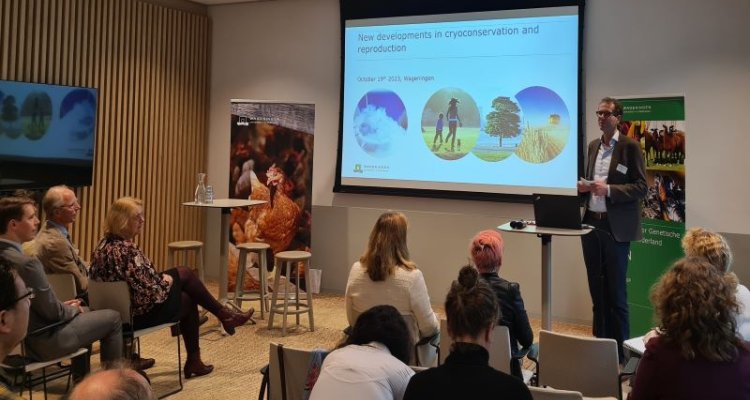
News
Symposium on new developments in cryoconservation and reproduction: a recap of a successful day
Cryopreservation of animal genetic material can make a major contribution to increase progress in important traits related to efficiency, health and resilience, but there is still a lot of work to be done.
The symposium ‘New developments in cryoconservation and reproduction’ took place on Thursday the 19th of October at Omnia, the Dialogue Centre of Wageningen University & Research (WUR). National and international visitors and speakers were welcomed by Sipke Joost Hiemstra, head of the Centre for Genetic Resources, the Netherlands (CGN). The first keynote speakers to give a presentation were Louisa Zak, global platform lead in reproduction at Topigs Norsvin, and Erik Mullaart, senior researcher at CRV.
Louisa and Erik discussed new developments in cryoconservation and reproduction from the perspective of the breeding industry. Both speakers stressed the importance of developing efficient and usable vitrification protocols. Over the past 20 years, there has been an eightfold increase in IVP (in vitro production) of bovine embryos worldwide. Although the current standard methods for vitrification of embryos in the bovine breeding industry give good results, they are also time-consuming and labour-intensive. There is still improvement needed to make freezing protocols better and more efficient. For the swine industry, boar efficiency is much lower when using cryopreserved doses of sperm, and the technology for cryopreservation of swine embryos is still several years behind in comparison to the technology in the bovine industry.
Louisa’s and Erik’s duo presentation was followed by an interactive activity where the audience took part in discussions about recent in reproductive technologies in animal husbandry and conservation, and the need to preserve genetic diversity. The activity was led by WUR Animal Breeding and Genomics (ABG) and CGN experts Esther Ellen, Pauline Jehannet, Berenice Bernal Juarez and Annemieke Rattink. Together with the audience they discussed a wide range of topics, including whether preserving semen and embryos is enough to sustain livestock breeds, breeding lines or endangered species, if oocyte cryopreservation is ‘a lost cause’, and if and how reproduction organoids can aid the IVP of embryos.
After a short break, Marta de Ruijter-Villani, associate professor and clinical embryologist at the Faculty of Veterinary Medicine of Utrecht University, took the stage to give a presentation about post-zygotic aneuploidy in mammalian embryos. For cattle, half of the transferred IVF blastocysts do not result in a live calf, and less than 40-50 percent of fertilized oocytes develops into blastocysts. The primary cause for these failures is embryonic aneuploidy (incorrect chromosome number in the embryonic cells). IVM (in vitro maturation) and IVF increase the aneuploidy rate (in pigs and cattle, but also in humans). These findings illustrate that there is still progress to be made in order to increase the fertilisation rate for IVM and IVF.
The final keynote speaker was Dr Mike McGrew, professor and group leader at The Roslin Institute, UK, who gave a presentation on primordial germ cells (PGCs). Because chickens are one of few species in which PGCs can be propagated long-term in vitro and are germ line competent, it is interesting to investigate how this method can be improved and if the chicken PGC technology can also be applied to other bird species.
The final speaker of the day was Henri Woelders, senior scientist at the Animal Sciences Group of WUR and expert in the field of cryopreservation, who will retire after a very impressive and productive career at WUR and its predecessors.
Future research opportunities
After the presentations there was plenty of time for the attendees to exchange thoughts and discuss opportunities for future research. WUR is currently involved in a project with CRV and Topigs-Norsvin that focuses on the further development of cryopreservation (vitrification) protocols that will lead to good quality embryos (with high fertility rates) after freezing and thawing for both cattle and pigs. This research focuses on reproductive technologies that are also required to preserve genetic diversity and rare breeds, which means that both breeding companies and CGN will benefit from the results.
The Symposium on new developments in cryoconservation and reproduction was organised by WUR Animal Breeding and Genomics (ABG) and the Centre for Genetic Resources, the Netherlands (CGN)